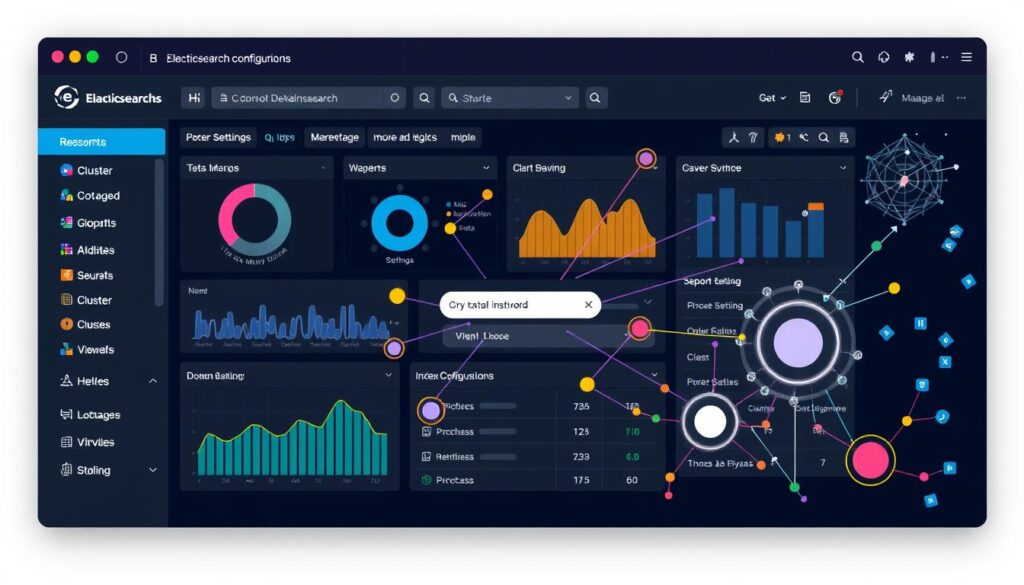
Did you know Elasticsearch can make query times 3.5X faster, and up to 40X during busy times? It’s a key tool for handling big data. This Elasticsearch tutorial will show you its powerful features. It will help you use it for your data needs.
Elasticsearch works with many data types and formats. This makes it very flexible for storing and getting data. It’s why big platforms like AWS, GCP, and Azure offer Elasticsearch as a service. You can also make live data dashboards with Elasticsearch, Kibana, and Splunk.
If you’re new to Elasticsearch or want to improve your use, this guide is for you. We’ll cover important topics like indexing, queries, and aggregations. We’ll also show you advanced search techniques. By the end, you’ll know how to get the most out of Elasticsearch, making your data easy to find and use.
Key Takeaways
- Elasticsearch can improve query response times by up to 40X during peak times.
- Supports various data types and formats for efficient storage and retrieval.
- Available as a managed service on AWS, GCP, and Azure.
- Allows creation and management of live data dashboards using Kibana and Splunk.
- Comprehensive guide for setting up, configuring, and optimizing Elasticsearch.
Introduction to Elasticsearch
Elasticsearch is a key player in today’s data world. It works as a search and analytics engine that’s open-source and very effective. It’s great at handling lots of data quickly across many systems. This intro explains what it does, its main features, and why it’s so useful.
What is Elasticsearch?
Elasticsearch is a fast search and analytics engine built on Lucene. It’s known for quick searches, strong analytics, and easy data exploration. It uses a RESTful API to store data in JSON, making it easy to work with other systems.
Overview of its Features
Elasticsearch has many features that make it essential for handling big data:
- Scalable and Distributed Architecture: It handles data across many nodes, growing as data does.
- Versatile Search Options: It supports many search types, like full-text and term-based searches.
- RESTful API: It makes querying and data manipulation easy, returning data in JSON.
- Aggregations and Analytics: It offers powerful tools for complex data analysis.
- Real-Time Data Processing: It indexes and searches data almost instantly, perfect for up-to-date insights.
- Data Visualization with Kibana: It works well with Kibana for detailed visualizations and interactive exploration.
- Multi-Tenancy: It supports many indexes in one place, great for shared environments.
Key Benefits of Using Elasticsearch
Elasticsearch offers more than just search. It brings many benefits for different business needs:
- Scalability: It grows by adding more nodes, improving performance and capacity.
- High Availability: It keeps data available with shard and replica management, even with node failures.
- Speed and Performance: It quickly processes and returns search results, ideal for fast data needs.
- Cost-Effectiveness: Being open-source, it’s affordable without losing functionality or performance.
- Integration Flexibility: It works with many data sources and systems, including the Elastic Stack, for a strong data ecosystem.
Table: Main Components of The Elastic Stack and Their Functions
| Component | Function |
|---|---|
| Elasticsearch | Search and analytics engine providing real-time data processing capabilities |
| Logstash | Data ingestion and processing tool, handling various data sources |
| Kibana | Data visualization tool for analyzing and visualizing Elasticsearch data |
| Beats | Lightweight data shippers for collecting and sending data to Elasticsearch or Logstash |
Setting Up and Configuring Elasticsearch
Starting with Elasticsearch means knowing the Elasticsearch installation steps and key settings for top performance. Once you get these basics, you can use Elasticsearch’s strong features.
Installation Steps
First, make sure you use the recommended JVM with Elasticsearch for the best support and security. Here’s how to install it easily on an Ubuntu machine:
- Add the Elasticsearch APT repository by importing the GPG key and adding the repository definition to `/etc/apt/sources.list.d/elasticsearch.list.
- Update your package lists using the `apt-get update` command.
- Install Elasticsearch with `apt-get install elasticsearch.
If you’re in a containerized environment, Elasticsearch container images make it easy to run Elasticsearch on various infrastructures like AWS, GCP, and Azure.
Basic Configuration Settings
After installing, setting up Elasticsearch is key for the best performance and stability. The main config file, `elasticsearch.yml`, lets you change settings like node names, network settings, and data storage.
Elasticsearch uses a dynamic YAML config format. It’s best to avoid third-party Java agents to keep performance and stability high. Also, Elasticsearch works best with OpenJDK, not other JVMs.
Managing Elasticsearch config involves knowing dynamic and static settings. Most settings can be changed on a running cluster with the Cluster update settings API, with little downtime.
| Parameter | Description | Configuration Type |
|---|---|---|
| node.name | Assigns a name to the node | Static |
| path.data | Defines the storage location for data | Static |
| cluster.name | Specifies the name of the cluster | Static |
| network.host | Configures the network interfaces for binding | Static |
| discovery.type | Specifies the discovery mechanism | Static |
| cluster.routing.allocation.awareness.attributes | Configures attribute-based allocation routing | Dynamic |
| indices.recovery.max_bytes_per_sec | Sets maximum bytes per second during recovery | Dynamic |
| cluster.routing.allocation.disk.threshold_enabled | Enables or disables disk-based shard allocation | Dynamic |
A good Elasticsearch config improves performance and makes it reliable and flexible as your needs grow. With these steps and settings, you’re ready to use Elasticsearch’s full power.
Indexing and Searching Data in Elasticsearch
Elasticsearch is great at indexing and searching data. It’s one of the top 10 DBMS and has REST APIs for storing and searching data. It’s fast, delivering search results in milliseconds.
Elasticsearch uses inverted indices for quick searches. It stores data in JSON documents, which are grouped into indices. Each document has key-value pairs and metadata like _index and _id.
- Inverted Indexes: Enabling fast searches through structured data representation.
- JSON Documents: The fundamental format for representing data in Elasticsearch.
- Indices: Collections of documents sharing similar traits, acting as a logical storage unit.
Elasticsearch clusters have many nodes for distributing operations. These nodes handle queries efficiently. Indices are split into shards for fault tolerance and redundancy.
Elasticsearch makes mapping fields flexible. It has dynamic mapping for automatic field detection and explicit mapping for precise control. This flexibility is useful for different data scenarios.
The Elastic Stack includes tools like Kibana, Logstash, and Beats. Kibana offers visualizations of data. Logstash processes data for indexing. Beats ship data efficiently.
| Feature | Description |
|---|---|
| Inverted Indexes | Efficient search operations via pre-sorted lists of terms. |
| JSON Documents | Structured data representation using key-value pairs. |
| Indices | Logical namespaces to store and organize documents. |
| Shards | Subdivisions of indices to enhance performance and redundancy. |
| Dynamic Mapping | Automatic detection and mapping of field data types. |
| Explicit Mapping | Manual definition of field data types for precise control. |
| Kibana | Real-time data visualization tools. |
| Logstash | Data aggregation and processing tool. |
| Beats | Lightweight data shipping agents. |
Understanding Elasticsearch indexing and searching is key. It lets us use its full power for fast, accurate data analytics.
Advanced Searching and Querying Techniques
Exploring Elasticsearch’s advanced search techniques is key. These methods help us find valuable insights in big datasets. We’ll look at using filters and aggregations, nesting fields in queries, and the Elasticsearch query language.
Using Filters and Aggregations
Filters make our searches better by focusing on the right data. Elasticsearch’s filters, like Term, Range, and Bool, help narrow down results. This makes our searches more accurate and efficient.
- Term Filters: Finds documents with specific terms.
- Range Filters: Gets documents in certain ranges.
- Bool Filters: Uses logic to combine filters.
Aggregations help us analyze and summarize big datasets. They include Types like Terms, Histograms, and Date Histograms. These tools help us create detailed statistics for business decisions.
| Type | Description | Application |
|---|---|---|
| Terms Aggregations | Groups documents by unique values. | Analyzing categorical data. |
| Date Histogram | Organizes data by date intervals. | Time-series analysis. |
| Range Aggregations | Divides data into ranges. | Statistical studies. |
Nesting Fields in Queries
Nesting fields makes our queries more specific. It’s crucial for structured data where we need to capture relationships. Nesting fields lets us search deeply within documents, making sure we don’t miss anything.
- Nested Queries: Perfect for nested objects.
- Path: Shows the path for nested documents.
- Inner Hits: Gets details of the nested document.
Elasticsearch Query Language Overview
The Elasticsearch query language (Query DSL) is powerful. It lets us build complex queries and analyze data deeply. Knowing this language helps us use Elasticsearch to its fullest for data discovery and insights.
Key parts of the Elasticsearch Query DSL include:
- Match Query: Finds documents by full-text search.
- Term Query: Looks for exact terms in fields.
- Range Query: Finds documents in numerical or date ranges.
- Bool Query: Uses logic to combine queries.
These queries help us do detailed searches with many conditions. This opens up new ways to analyze data deeply, helping us make better decisions.
Scalability and Performance Tuning
To get the most out of Elasticsearch, you need a solid plan. This includes managing your cluster well and tweaking settings. Let’s dive into the key steps, like growing your cluster and fine-tuning settings.
Cross-cluster replication (CCR) is a key tool for scaling. It helps with disaster recovery and makes data closer to users. Cluster snapshots also help quickly get back up and running if something goes wrong. Using many nodes and spreading data out helps keep things running smoothly.
| Strategy | Details |
|---|---|
| Cluster Design | Tune for resilience, speed, disk usage |
| Performance Monitoring | Integrated with Kibana |
| Node Management | Handled automatically in Elastic Cloud Serverless |
| Memory Allocation | 50% for filesystem cache |
| Storage Configuration | SSD drives and local storage preferred |
To boost Elasticsearch, it’s important to balance shard copies across nodes. This makes your system more reliable and efficient. For better performance, there are a few tweaks you can make.
For example, setting readahead to 128KiB on Linux can speed up searches. Also, using 50% of memory for filesystem caches helps a lot. These small changes can make a big difference.
It’s also wise to use SSDs for faster searches and quicker CPUs for tasks that need lots of CPU power. Making your data easier to access and reducing the number of fields in indexes can also speed up queries. Plus, pre-indexing data can make searches even faster.
Our experience shows that fine-tuning Elasticsearch involves a few key steps. For instance, setting bulk request sizes to 5-15MB and controlling memory for indexing can help. Also, using time-based indexes for better shard management is a good idea. These tips come from lots of testing to make sure they work well for different situations.
By following these best practices, you can make the most of Elasticsearch. This will ensure your system runs smoothly and scales well.
Conclusion
Our journey through this article has shown how Elasticsearch is more than a search engine. It started in 2010 by Shay Banon. Now, big names like Netflix, Walmart, and eBay use it for search and data analysis.
We’ve seen how Elasticsearch handles big data. It breaks down data into shards for better handling. This makes data distribution and fault tolerance easier. It also works well with many programming languages, making it a great choice for developers.
Learning Elasticsearch is key. It helps you get the most out of its APIs for searches and data. It’s part of the Elastic Stack, which includes Logstash and Kibana. This opens up a lot of possibilities for data insights.
In short, Elasticsearch helps businesses deal with complex data. It’s fast, scalable, and essential for data analysis. By mastering Elasticsearch, we can make better decisions and innovate in many fields.
FAQ
What is Elasticsearch?
Elasticsearch is an open-source tool for searching and analyzing data. It handles big data quickly and efficiently. It’s popular for its fast search and complex data analysis.
What are the key features of Elasticsearch?
Elasticsearch is known for its fast search and strong analytics. It also has a flexible API for data exploration. These features make it great for working with data.
What are the benefits of using Elasticsearch?
Elasticsearch is scalable and processes data in real-time. It’s designed to handle large data sets efficiently. It also offers powerful search and a wide range of queries.
How do I install Elasticsearch?
Installing Elasticsearch is easy. First, download the package from the Elasticsearch website. Then, extract the files, set up the configuration, and start the service.
What basic configuration settings should I know?
You need to set up cluster and node names, and data paths. The elasticsearch.yml file is key for performance. It helps manage data efficiently.
How do I index and search data in Elasticsearch?
Indexing data means creating indices and mappings. Then, add JSON documents. Searching uses powerful queries to find what you need.
What advanced searching techniques does Elasticsearch offer?
Elasticsearch has filters, aggregations, and nested fields for advanced searches. These features help with detailed and complex data analysis.
What is the Elasticsearch Query Language (EQL)?
The Elasticsearch Query Language lets users create complex search queries. It supports various search operations, including full-text and structured searches.
How does Elasticsearch handle scalability?
Elasticsearch is great at scaling horizontally. You can add more nodes to handle more data. This ensures high availability and fault tolerance.
What are the best practices for performance tuning in Elasticsearch?
To improve performance, adjust JVM settings and optimize shard allocation. Also, monitor cluster health regularly. These steps help Elasticsearch run smoothly.
Future App Studios is an award-winning software development & outsourcing company. Our team of experts is ready to craft the solution your company needs.










